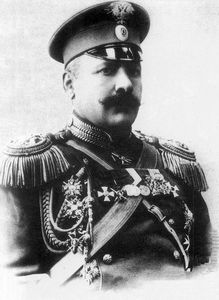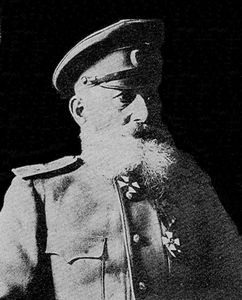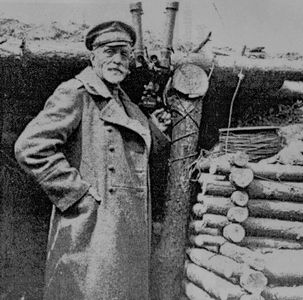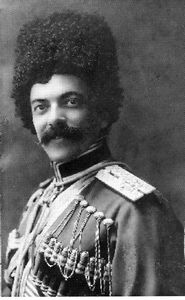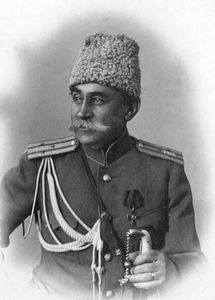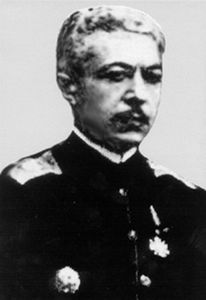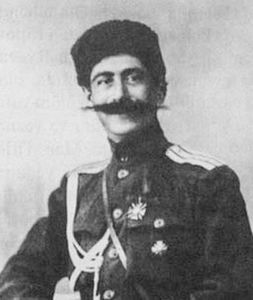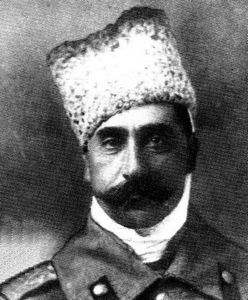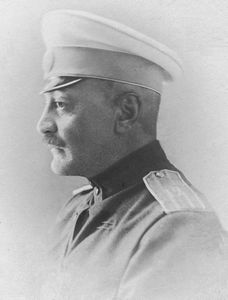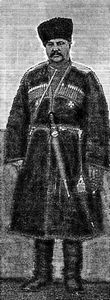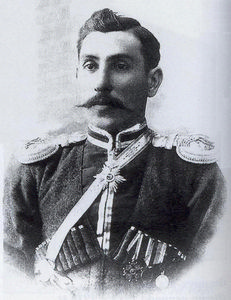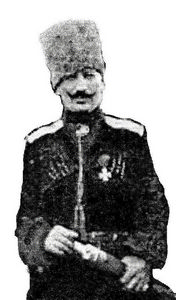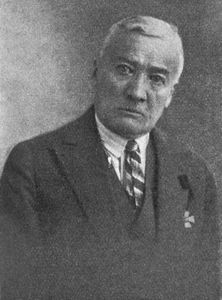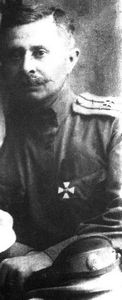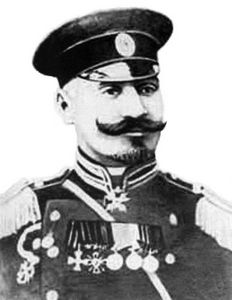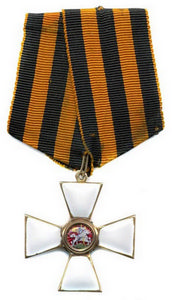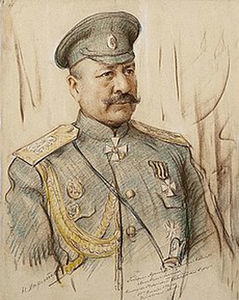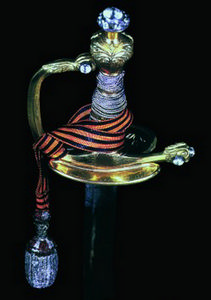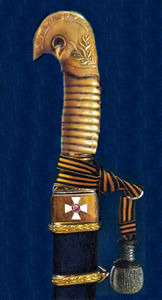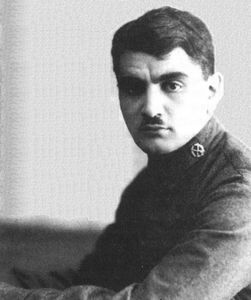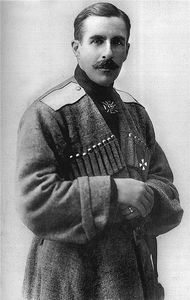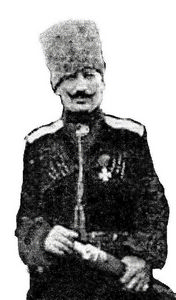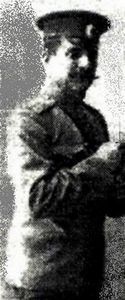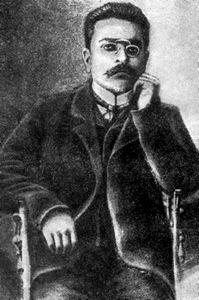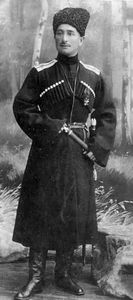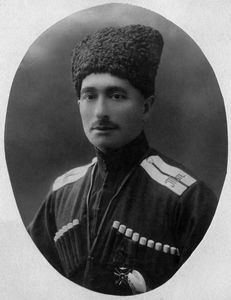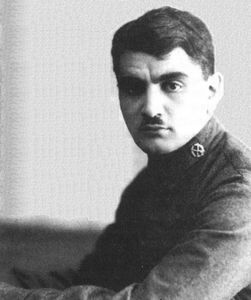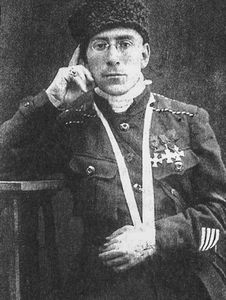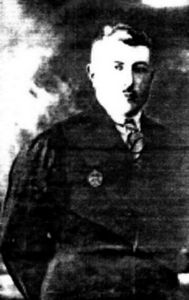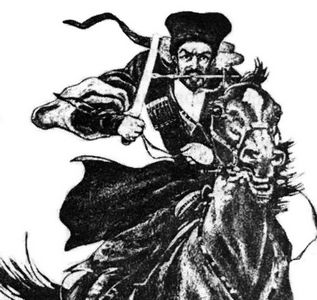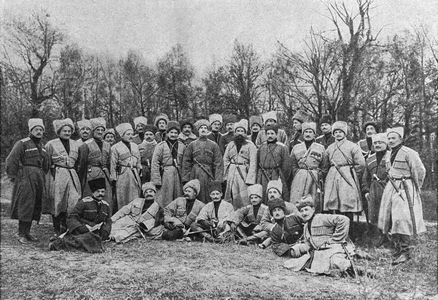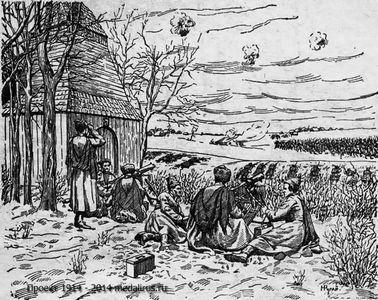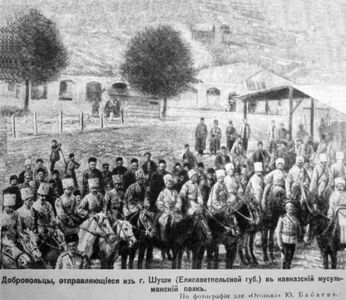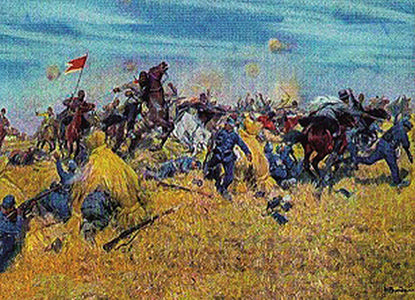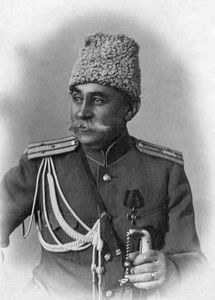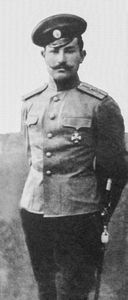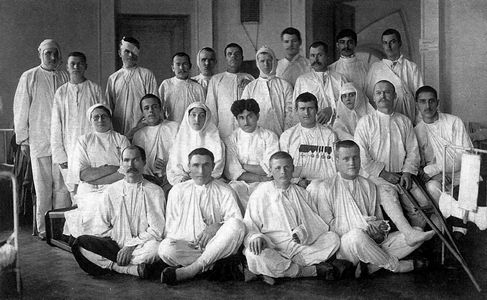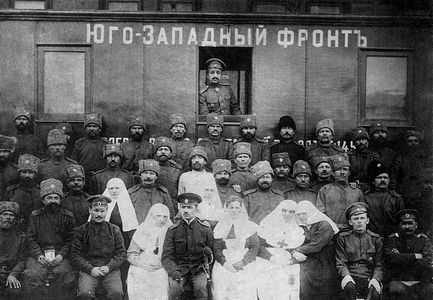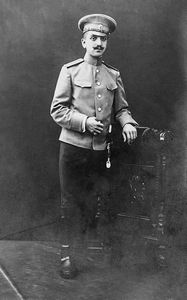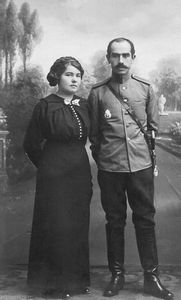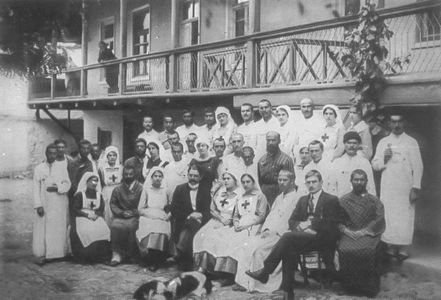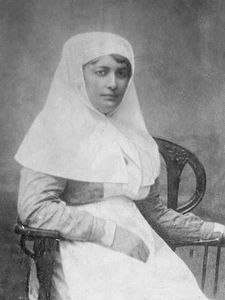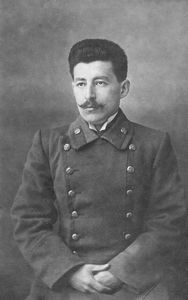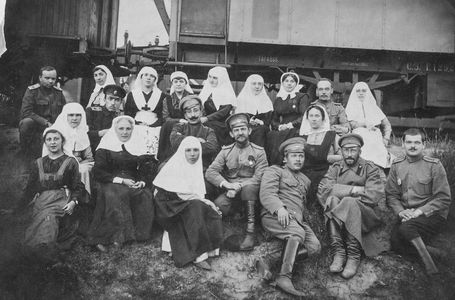Azerbaijani commanders on the fronts of World War I
Though since 1886, Muslims have not been called up for military service in the Russian army, but representatives of aristocracy had the right to enter specially designated educational institutions as military schools, in order to be officers.
Over 200 of Azerbaijani officers were distinguished for service in the ranks of the Russian army during World War I. The highest military ranks in the Russian army were held by General of cavalry, General - adjutant Huseyn Khan Nakhchivanski - the commander of Cavalry Guards Corps, General of the Artillery Samed Bey Mehmandarov - the commander of 2nd Caucasian Army Corps, General- lieutenant Ali agha Shikhlinsky - the commander of 10th Army.
Samed Bey Mehmandarov (1855-1931) graduated from Baku gymnasium, 2nd Constantine Military School, Officer’s artillery college; in Russo-Japanese war 1904-1905 he was awarded the Order of Saint George of IV class. During World War I Major-General Mehmandarov became the commander of 21st Infantry Division. In December 1914, he was appointed the commander of 2nd Caucasian Army Corps. During his military service, General of the artillery Mehmandarov was awarded the Order of Saint George of III class and IV class, as well as the Order of Saint Stanislaus (of any classes), including the Order of Saint Anne (of any classes), the Order of Saint Vladimir of IV, III and II classes , the Order of the White Eagle with swords, the Order of Saint Alexander Nevsky with swords, the Golden weapon inscribed “for bravery”, the Brilliant gun and other highest military rewards of Great Britain, France and Romania.
Guseyn khan Nakhchivanski (1863-1919) was brought up in Pazhsky corps; in Russo-Japanese war 1904-1905 was awarded the Order of Saint George of IV class. During World War I General-lieutenant Nakhchivanski became the commander of the 2nd Cavalry Division. In October 1914, he was appointed the commander of 2nd Cavalry Corps.
In June 1915, Nakhchivanski was promoted to the rank of General- adjutant of Emperor, and in April 1916, he was appointed the commander of Cavalry Guards Corps. For military service Huseyn Khan Nakhchivanski was awarded the Order of Saint George of III class and IV class, as well as awarded the Order of Saint Stanislaus (of any classes), the Order of Saint Anne (of any classes), the Order of Saint Vladimir of IV, III and II classes, the Order of the White Eagle with swords, the Golden weapon with an inscription “for bravery”, including other highest military rewards of Great Britain, Prussia and Romania.
Ali agha Shikhlinski (1865-1943) studied at Tiflis Cadet Corps, Mikhaylovsky Artillery College, and entered Officer’s Artillery College. He participated in “Chinese expedition” of the Russian army and in Russo-Japanese war. For the courage in defense of Port-Arthur, he was awarded the Order St.George IV class. In 1907 Shikhlinski invented an original target-finding device, included in artillery theory, which was called “Shikhlinski triangle”. Since 1908 he started teaching at Officer’s Artillery College. Ali agha Shikhlinski was the author of military-related scientific publications like “The instructions for organization of the maneuvers in Artillery Division”, “Use of Field Artillery in a Battle”, “On Artillery firing over heads of your own troops”. His publications were widely spread and played an important role in development of artillery science, afterwards, Shikhlinski was called “the lord of Russian artillery”. In 1913 he was conferred the rank of Major- General, since 1914, he became the principal of Officer’s Artillery College.
Since January, 1915 Shikhlinski was the commander of heavy artillery of North-Western front, and since October, he was appointed to the position of the general for errands of artillery at the Supreme Commander-in-Chief being the commander of the whole heavy artillery of the Russian Army. Since April, 1916 he held the position of inspector of artillery at the Western front and participated in a number of military operations. In April, 1917 he was conferred the rank of Major General, and appointed the commander of 10th Army. During military service A.Shikhlinsky was awarded the Order of St.George IV class, the Order of St. Stanislaus (of any class), the Order of St.Anne (of any class), the Order of St. Vladimir II, III and IV classes, Gold Georgiyevsk weapon, Officer’s and Commando’s crosses of French Legion honours.
Generals:
Ibrahim Agha Usubov (1872-1920) studied at Tiflis Military School and entered Constantine Military College, infantry officer. Participant of Russo- Japanese war. Major-General, the commander of 133rd Brigade of infantry division.
Mir Kazim Bey Talishinski (1855-1938) studied at Baku Realny School and 2nd Constantine Military College, infantry officer. Participant of Russo- Turkish war 1877-1878. He was conferred the rank Major-General and during World War I was appointed the commander of 3rd Siberian rifle regiment.
Feyzulla Mirza Qajar (1872-1920) studied at Tiflis Military School and Nikolayevsky cavalry college. Participant of Russo-Japanese war. Major -General, the commander of 2nd Brigade of the First Caucasian Aboriginal cavalry division. On September 30, 1917, he was appointed commander of the First Caucasian Aboriginal cavalry division
Mir Asad Bey Talishkhanov (1857-1919) studied at Baku Realny School and 2nd Constantine Military College, he graduated Officer’s Artillery College. Major- General, the commander of 52nd Artillery Brigade.
Sadiq Bey Aghabeyzadeh (1865-1944) studied at Baku Realny School and 2nd Constantine Military College, infantry officer. Major- General.
Amanulla Mirza Qajar (1857-1937) Infantry officer. Participant of Russo- Japanese war. Major- General, the commander of the First Kuban infantryman brigade.
Biography information and participation in World war I Major- General Aliyar Bey Hashimbeyov (1856-1920), Major-Generals Firidun Bey Vezirov (1850- 1925) and Khalil Bey Talishkhanov are being defined.
Colonels:
Javad Bey Shikhlinski (1874-1959) studied at Tiflis Military School and 2nd Constantine Military College, Artillerist. Colonel, the commander of division 45th Artillery brigade.
Suleyman Bey Efendiyev (1864-1919) studied at Elizabethpol School and Elizabethgrad cavalry college. Participated in World War I and held a rank of cavalry division colonel of Ministry of Internal Affairs.
Davud Bey Yadigarov (1883-?) Studied at Page Corps and served in Cavalry divisions as a colonel.
Abdulhamid Bey Gaytabashi (1884-1920) studied at Pavlov Military college, infantry officer. Colonel of 205th infantry Shamakhi regiment of 52nd infantry division.
Habib Bey Salimov (1881-1920) - studied at Erivan School and Tiflis infantry cadet college, graduated Military Academy of General Staff. By 1917- colonel of General Staff.
Ibrahim Agha Vekilov (1853-1934) studied at Tiflis geodetic college and Petersburg college of military topographers. The first military topographer of Azerbaijan. Colonel (first military topographer in Caucasus who was conferred the rank of “colonel”).
Mansur Mirza Qajar (1869-1931) studied at Vladikavkaz Realny College and Elizabethgradsky cavalry college, as well as entered Officer’s cavalry college. Participant of Russo-Japanese war. Colonel, the commander of 12th hussar Akhtyr regiment.
Boris (Askar) Bey Sofiyev (1872-1934) studied at Pskov Military School and 3rd Alexander Military College, as well as graduated Officer’s Artillery school. Participant of Russo-Japanese war. By 1917-colonel, the commander of the first division of 57th artillery brigade.
Teymur Bey Novruzov (1880-1961) studied at Tiflis Military School, Elizabethgradsky cavalry cadet College, as well as Officer’s cavalry school. Colonel, the commander of cavalry division.
Teymur Mirza Mammadalibeyov (1873-1916) studied at 2nd Moscow Military School, 3 rd Military Alexandrovsky College, as well as Officer’s Artillery college and Nikolayevsky Academy of General Staff. Participant of Russo-Japanese war. In June 1916, was promoted to the rank of colonel, died in a battle in early September, 1916
Darab Mirza Qajar (1869-1930) studied at Tiflis Military School and Pavlov Military College. Officer of Cossack army with the rank of Colonel
Kelbali Khan Nakhchivanski (1891 – until 1931) at Tiflis Military School, Nikolayevsk cavalry college, was rewarded with Georgiyevsky weapon. Colonel of Life Guards of His Majesty’s uhlan regiment.
Seyfulla Mirza Qajar (1864-1926). Infantry officer. Colonel, the commander of 15th Zaamursky frontier infantry regiment.
Mamed Quli Mirza Qajar (1872-1920) studied at Simbirsk Military School, Alexandrovsky Military College, as well as Officer’s Artillery School. Colonel, the commander of 5th Caucasian detached rifle unmounted artillery division.
Fathali Mirza Qajar (1855-?) studied at Pazhesky Military School. Participant of Russo-Turkish (1877-1878), he resigned in 1913 and called up at the beginning of World War I. Colonel, the inspector of medical institutions in Petrograd city.
Alexander Reza Quli Mirza Qajar (1869-1943) studied at Vilensky infantry cadet college. Colonel of Kubansky sotnia of emperor’s escort.
Azerbaijanis awarded the Order of St. George during World War I
Imperial Russia's highest exclusively military order and the most honorable reward was “Imperial Military Order of Saint Great Martyr and Victorious George” (the Order of St. George), under the slogan – “For service and heroism”. The Order of St. George came in 4 classes and initially was to be considered exclusively as battle reward for military heroism. Awarded the Order of St. George had significant privileges as well as were ennobled (Russian hereditary). From 1828 to 1913 the holders of the Order of St. George became 31 Muslims, out of them 11 were Azerbaijanis, the only Muslim holder of the Order of St. George 3rd class among them was Azerbaijani Minatul Bey Heydarov.
In 1914-1917, 3 Muslims were awarded the Order of St. George 3rd class, out of them 2 were Azerbaijani and 1 Chechen.
1.Huseyn Khan Nakhchivansky (1863-1919)-General-adjutant, Cavalry.
2.Samed Bey Mehmandarov (1855-1931) - General of artillery, artillery
In 1914-1917, 8 Azerbaijanis were awarded the Order of St. George 4th class:
1.Boris (Asker) Bey Sofiyev (Safiyev) (1872-1934) –colonel, artillery.
2.Teymur Bey Novruzov (1880-1961) colonel, cavalry.
3.Teymur Mirza Mammadalibeyov (1873-1916)-colonel, artillery, died in a battle.
4.Rashid Bey Efendiyev (1880-?) captain, infantry
5.Ibrahim Agha Usubov (1875-1920) Major-General, infantry
6.Feyzulla Mirza Qajar (1872-1920) Major-General, cavalry
7.Israfil Bey Khalilbeyov (?-?) captain, armored vehicle element
8.Farrukh Agha Gayibov (1891-1916) - (poruchik, first) lieutenant, died in a battle.
Azerbaijanis rewarded with Georgievsky weapon in 1914-1917
One of the most honorable military rewards of the Russian empire, equated with the Order of Saint George was “Georgievsky weapon”- the Brilliant gun and the Golden weapon.
From 1828 to 1913, 27 Azerbaijanis were rewarded with Georgievsky weapon.
In 1914-1917, 8 colonels were awarded the Brilliant Georgievsky weapon, out of them one Muslim Azerbaijani Samed beg Mehmandarov
1.Samed Bey Mehmandarov (1855-1931)- General of Artillery, artillery
In 1914-1917, 15 Azerbaijanis were awarded the Golden Georgievsky Weapon:
1.Darab Mirza Qajar (1896-1930) colonel, cavalry
2.Boris (Asker) Bey Sofiyev (Safiyev) (1872-1934) – colonel, artillery.
3.Kelbali Khan Nakhchivanski (1891-1931) – colonel, cavalry.
4.Siyavush Mirza Qajar (1889-?) – sotnia, machine-gun elements.
5.Mansur Mirza Qajar (1869-1931) – colonel, cavalry.
6.Teymur Mirza Mammadalibeyov (1873-1916) – lieutenant-colonel, artillery.
7.Mir Asad Bey Talishkhanov (1857-1919) – Major-General, artillery.
8.Amanulla Mirza Qajar ( 1857-1937) – Major-General, infantry
9.Mahmud Bey Zeynalov (1888-?) – stabs-captain, cavalry
10.Jamshid Khan Nakhchivanski (1895-1938) – stabs-rotmistr, cavalry
11.Seyfulla Mirza Qajar (1864-1926) – colonel, infantry
12.Jalal beg Sultanov (1879-1916) – stabs-rotmistr, cavalry, died in a battle
13.Israfil Bey Khalilbeyov (?-?) – captain, armored vehicle element
14.Naghi Mammadaliyev (1895-?) – (first lieutenant) poruchik, infantry
15.Kerim Khan Erivanski (1885-1937?) – stabs-rotmistr, cavalry
Tatar (Azerbaijani) cavalry regiment
Regiment’s formation
During World War I in the Russian Imperial Army was created a unique military unit comprising of Azerbaijanis. As is known, Azerbaijanis in the empire were called “Trans-Caucasian tatars”, so the regiment was named Tatar cavalry regiment. Muslims in the Russian Empire had not been called up for military service and therefore, the regiment was created on voluntary base.
On July 27, 1914 emperor Nicholas I permitted to create national regiments consisted of volunteers-muslims of the Caucasus. Tatar (Azerbaijan) regiment was formed in Elizavetpol (Ganja), though volunteers arrived from throughout of Azerbaijan to the city to serve in this regiment. Regiment’s formation was organized by staff captain cavalry Shahverdi Khan Ziyadkhanov. The regiment was composed of 22 officers, three military officials, 1 regiment’s mullah, 575 riders and 68 non-combatant lower ranks. The commander of the Tatar cavalry division was appointed lieutenant colonel P.Polovtsev, assistants of the commander were-V.Staroselsky and Sh.Ziyadkhanov, Feyzulla Mirza Qajar. The mullah of the regiment was well- known and enlightener Muhammmad Hadi. A major role played the representatives of national bourgeoisie, bought at their own expenses clothes and outfit, as well as an engineer and enlightener Farrukh Bey Vezirov.
In accordance with the resolution, regiment’s cavalry squadron was made up of muslims, but out of 22 officers only 8-10 were from the reviewed region, the rest of them were either Russians or representatives of other nations.
In Tatar (Azerbaijan) regiment served officers-azerbajanis: Shahverdi Khan Ziyadkhanov, Jalal Bey Sultanov, Israfil Bey Yadigarov (Mahammad Bey Nabi oghlu), Jamshid Khan Nakhchivanski, Khudadad Bey Khudaverdov, Aslan Bey Kubatiyev, Zulfugar Bey Sultanov, Selim Bey Sultanov, Ali Murad Bey Vezirov, Zeynal Bey Sadikhov.
Azerbaijani officers also served in other Muslim regiments: for instance, Iskander Khan Nakhchivanski served in Chechen cavalry regiment, Karim Khan Erivanski in Kabardian regiment.
At the same time, together with Azerbaijanis served representatives of aristocracy of the empire from other nations: Russian graph N.Bobrinsky, A.Bers (nephew of Lev Tolstoy), A.Nemorovich-Danchenko, duke M.Muravyev-Amursky, duke S.Bagrathion-Mukhransky, kabardian Fyodr Nikolayevich (Tembot Jankhotovich) Bekovitch-Cherkassky, georgians duke N. Kazbegi, duke V.Amilokhvari, duke L.Magalov, abkhazian duke Khalit Shervashidze, osetian M.Khoranov, and even two french-Charles Testenaur and Obriyen de Lassi.
Tatar cavalty regiment before to go to the front under oath of allegiance took an “Oath” in the Azerbaijani language (in the documents it’s listed as Azerbaijani- Tatar dialect) allegiance to the emperor and the state.
After reciting the words of the oath, each of the riders signed under the “Jury list”.
Military operations of regiment
At the beginning of September, 1914 Tatar (Azerbaijan) cavalry regiment was organized, allotted to the Caucasian Aborigen Cavalry Division and for its undertaken battlefield operations was called “Wild Division”. The regiment was made up of Chechen, 2nd Dagestanian, Kabardian, Ingushetian, Circassian regiments. A uniform of division was made on the base of Caucasian men’s outfit - boots, trousers, shirt, cherkesskas, papakha (hat), bashlyk.
The cherkesskas, hats, shirts and pagonas worn by the warriors of each regiment were different in color.
Tatar cavalry regiment had black colored shirts, cherkesskas and papakha with red colored epaulets bearing yellow colored cypher “T”.
The commander of the division was appointed the younger brother of Tsar, Grand Duke Michail Alexandrovich.
November 1914 - July 1917, Tatar (Azerbaijan) cavalry comprising the division took part in large-scale operations of the Russian army at South-Western front.
Tatar (Azerbaijan) cavalry regiment’s soldiers were awarded with numerous military rewards. Six officers of the regiment were awarded the Order of St.George IV class. Five officers (one of them Jalal beg Sultanov was awarded posthumously) were honoured with Georgiyevsky weapon.
Being full cavaliers of Georgiyevsky, in other words rewarded with George- Crosses (of IV classes) became cavalry squadron Alibek Nabibeyov, Sayad Zeynalov, Mehdi Ibrahimov, Alekber Hajiyev, Datso Daurov, Alexandr Kaytukov. Osman Agha Gulmammadov was awarded three George-crosses and three Georgiyevsky medals.
Zeynal Bey Sadikhov was awarded three George-crosses and Georgiyevsky medal, and when he became the officer was rewarded with four military medals.
Azerbaijanis for undertaken battlefield operations in other regiments of the division distinguished themselves in Kabardian regiment - Hamid Alesgerov, Mansur Aliyev, in the 2nd of Dagestanian regiment- Veli Bey Yadigarov, Ali Hajiev in Chechen regiment- Mahammad Sadikhov, Jabrayil Shahtemirov, Ibrahim Saidov, Mahammad Aliyev, in Circassian regiment-Mustafa Mardov and others.
Due to heavy losses Tatar cavalry regiment increased in size four times by new volunteers from Azerbaijan.
Till the end of the war the regiment remained faithful to oath of allegiance and was called off the front during the fall of empire as the regiment opposed participation in civil war. In autumn 1917, Tatar (Azerbaijan) cavalry returned to Caucasus, in Tiflis. Later this regiment became the most militant equestrian unit of the Caucasian Islamic Army and the first military unit of the Azerbaijan Army.
Ibraghim agha Vekilov - First military topographer of Azerbaijan
Ibraghim agha Vekilov (1853-1934) graduated Tiflis geodetic college and entered Military-Topographic College in Petersburg. Since 1879 Vekilov served in military-topographic department of Caucasian military district. He worked in topographical survey in Crimea, in the trans-Caspian region and Iran (Khorasan). He was the member of Russo-Persian Frontier Commission. By 1915 Vekilov became an assistant chief of Military-Topographical Department Staff of army. In April 1917, he was conferred the rank of colonel and the first military topographer who was conferred this rank in Caucasus. Vekilov made topographical maps of Kars area and Alashkert region of Turkey, as well as Tabriz, Khoy and Urmiya.
He was decorated with a number of orders of Empire.
Farrukh agha Gayibov - First military aviator of Azerbaijan
Farrukh Agha Gayibov (1891-1916) studied at the Russian-Azerbaijan school, and then he continued his education at Tbilisi Cadet Corps. In 1910, he entered Constantine Artillery College and served as artillery officer. In February 1916, lieutenant Gayibov was sent to the Western Front and he was assigned as artillery officer of “Ilya Muromets № 16” airplane. Gayibov together with his squadron of airship repeatedly made operation flights. On September 12, 1916 the air squadron made operation flight bombing the largest enemy’s centre Borun city (present-day territory of the Republic of Belarus). In the air warfare on board the “Ilya Muromets № 16” destroyed four enemy’s fighter bombers, and this situation made possible for other bomber airplanes to raid enemy positions by accurate bomb attacks, but the crew of aircraft was shot down. Germans buried the crew of aircraft with military honours. Gaibov in battles was decorated with a number of rewards. And he was posthumously awarded the Order of Saint George IV class.
Afterwards, the monument in memory of the fallen aircraft was erected in the territory where the aircraft had been shot down near Borun city.
Azerbaijani medical officers
During World War I, Azerbaijani doctors worked on various fronts. Some of them - professional military doctors - have a special place in the history of medicine in Russia and Azerbaijan.
Mustafa Mahmud oglu Hajiqasimov (1883-1959). Graduate student of medical faculty of Kharkov University. In 1914-1918 worked as a doctor in “Kharkov field hospital for wounded and injured soldiers’’.
In 1919 came back to Azerbaijan. In 1926 he left courses of gynecologists in Europe. In 1927 organized Azerbaijan Obstetrics technical school. Being a director of technical school M. Hajiqasimov has done a great job in preparation of medical personnel. Author of 23 scientific works, professor, “Honored doctor”, and two years after “Honored Scientist”. From 1952 to 1956 he was a head obstetrician- gynecologist of the Azerbaijan SSR.
Ali Mukhtar Aliyev (?- 1954). Graduate student of medical faculty of Kiev University. In 1914-1918 he was on the front-battles. By 1938 he had become the head of the hospital train of South-Western front. He was awarded with honor medals of the Russian Empire. In 1917 he returned to Baku and worked in Mikhaylovskaya hospital. In 1938 he was subjected to repression. In 1941 he was released from prison, and afterwards, again started working as a doctor.
Ali Bey Alibeyov (1873-?). Graduate student of medical faculty of Kiev University. In 1916-1918 served as medical officer on the South-Western front. In 1918-1923 worked in Chechnya where he established a number of medical centers (institutions). Since 1923 in Baku. He was an organizer of the established republican sanitary service in 1924 In 1923 he became the head of Public Health Organization Department of Azerbaijan medical institute. Author of over 60 scientific works, “Honored scientist”.
Firuz Ordubadski (1889 -?). Graduate student of medical faculty of Kiev University. In 1914-1917 worked as the head of the hospital train on the fronts. In 1925 the pedagogue of Female school named after N. Narimanov. In 1937 F. Ordubadski was subjected to repression, and his further fate remained unknown.
Ali Heydar Allahverdiyev (1888-?). Graduate student of medical faculty of Kiev University. In 1914-1916 he worked in Kiev hospital №4 of the All-Russian Zemskiy (zemstvo - elective district council in pre-revolutionary Russia) Soyuz (union). In 1916-1918 a medical officer of one of the hospital train of the Western front. In 1921 A.H. Allahverdiyev was appointed the head of the medical-sanitary Railway Department of Azerbaijan Narkomzdrav (the People's Commissariat of health). By his direct assistance was established Mardakan rural hospital and ambulances at railway stations. In March 1922, he was appointed the head of public health service of the Caspian shipping (steamship line). He opened the hospital of shipping (Kaspar) with 120 beds, a central clinic, and a clinic in Bayilovo, the first physiotherapeutic hospital and children’s clinic. Since 1934 an organizer and the first director of “Naftalan” resort. On June 23, 1941 he was called up for military as a medical doctor. Until 1945 he headed a number of evacuation hospitals. In 1945-1952 worked at Azerbaijan State Institute of advanced medical studies. From September 1952 worked at Azerbaijan Medical Institute.
Aga Khan (Mir Abulfat Khan) Talishinski (1885-1949). Graduate student of medical faculty of Kiev University. In 1916-1917 he served in Kharkov hospital of Red Cross Society.
In 1917 he returned to Azerbaijan, a doctor of surgical department of Baku city hospital. From 1920 he worked in department of common surgery of Baku State University. In 1930 he established a department of traumatology in Baku hospital named N. A. Semashko. In 1935 he issued the first tutorial on traumatology for students of medical institute in Azerbaijani language. Doctor of medical sciences, professor. In 1938-1944 he was deputy of traumatology and orthopedics department and field military surgery of Azerbaijan institute of advanced medical studies. In 1941-1945 was the head surgery of military hospital. In 1946 he founded Baku Research Institute of traumatology and restorative surgery.
